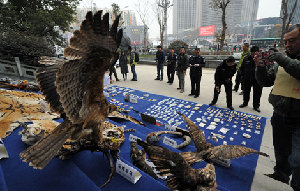China leads int'l wildlife crime bust
Updated: 2014-02-10 08:53
(Xinhua)
|
||||||||
BEIJING - Tonnes of illegal animal products have been seized and over 400 suspects arrested in an China-led sting against international wildlife crime, authorities said on Monday.
The operation cleaned up over 350 cases, capturing more than 3 tonnes of ivory and its products, over 1,000 hides, 36 rhino horns and a large number of other wildlife products, said the China Endangered Species Import and Export Management Office.
|
Related: |
|
 |
| Yunnan busts wildlife trafficking case |
The operation, codenamed Cobra II, was co-organized by China, the United States, South Africa, the Lusaka Agreement Task Force, the ASEAN Wildlife Enforcement Network, and the South Asia Wildlife Enforcement Network.
The global crackdown was supported by the Convention on International Trade in Endangered Species of Wild Fauna and Flora (CITES), the World Customs Organization, and Interpol. A total of 28 countries participated between December 30, 2013 and January 26, 2014.
China's authorities, including forestry, customs, police, judiciary and quarantine departments, put more than 100,000 staff on the operation, and uncovered over 200 cases involving more than 250 suspects.
China sent enforcement staff to Kenya for the first time, to arrest an ivory trafficking suspect and host lectures on wildlife protection.
"China played a leading role in operation Cobra II," said Wan Ziming, director of the Law Enforcement Department with the China Endangered Species Import and Export Management Office.
China called for an international crackdown on wildlife crime in 2012, and led the first operation Cobra, involving 22 countries, in early 2013.
"Multinational operations are of great significance in the fight against wildlife crime rings," said John Scanlon, secretary-general of CITES.
China has rich wildlife resources with around 6,500 vertebrate species, about 10 percent of the world's total.
Over 470 terrestrial vertebrates are indigenous to China, including the giant panda, golden monkey, South China tiger and Chinese alligator.However, in some parts of the country the tradition of eating exotic wildlife as a delicacy persists. Some rare species are also used in traditional medicine.
To protect biodiversity, China has a long list of rare and endangered species that receive judicial protection, a complete legal framework in place and many laws and regulations at central and local levels.
China has paid great attention to the protection of endangered species since it joined CITES in 1981, with the world's largest CITES Management Authority and the National Interagency CITES Enforcement Collaborative Group, formed in 2011, to support concerted enforcement.
CITES awarded the collaborative group the Secretary-General's Certificate of Commendation in 2012 for two successful national wildlife law enforcement operations that resulted in significant seizures and arrests.
Zhang Jianlong, director of the collaborative group and deputy director of the State Forestry Administration, said China will continue to cooperate with other countries to strengthen wildlife protection and fully fulfil its international obligations.
Most Viewed
Editor's Picks

|

|

|

|

|

|
Today's Top News
Retirement age should be raised to 65: experts
Kerry to reaffirm positive US-China ties
ICBC beings operating in Peru
Visit keeps momentum going
Masuzoe wins Tokyo governor election
Shanghai tops Asia on fashion
Nanjing Massacre is undeniable
Lessons of history for Japan
US Weekly

|

|












